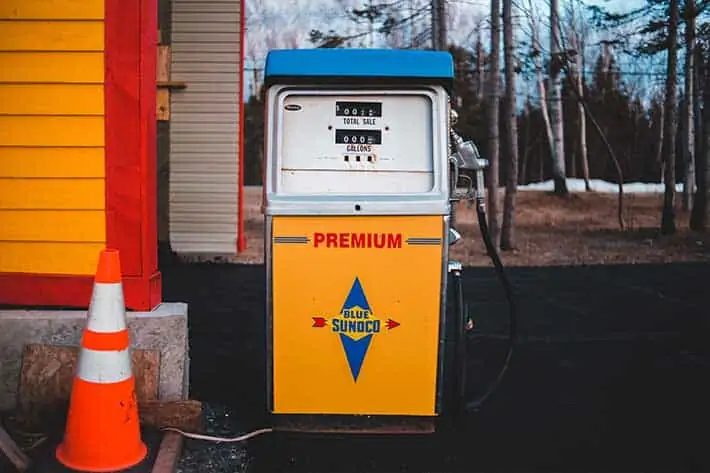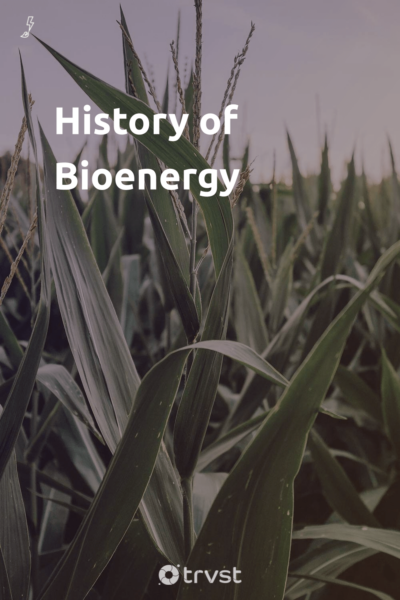History of Bioenergy
Most of us have heard of Bioenergy or biofuel. However, most of us might think this is a modern form of energy. This could not be any further from the truth because the history of bioenergy dates back centuries7.
There is a lot of evidence out there that suggests humans used bioenergy between 230,000 and 1.5 million years ago.
From the moment humans discovered fire, we began using biofuel in the form of wood. Humans have a long history of burning bio-matter to create energy used for cooking and heating. From this point forward, humans developed a fascination and ongoing relationship with what we now know today as bioenergy.

There is even a belief that it led to humans becoming more active, while it also could have resulted in an increase in our brain size, due to a rise in calorie consumption.
What is Bioenergy?
We use organic materials to create bioenergy. These materials can include the likes of wood, agricultural crops, and organic waste. We then use this material to produce bioenergy which can take the form of gas and electricity. However, it can also take the form of a liquid, enabling us to use it in vehicles.
Despite being one of the oldest forms of energy, it is also one that can help to underpin our efforts as we move away from fossil fuels and reduce carbon emissions1.
The History of Bioenergy Changed in the 19th Century
So, with humans initially using bioenergy for essential heating and cooking, come the 19th century, more modern uses began to appear. In the 1820s, fuel lamps made use of a blend of camphene and alcohol. In the USA, the sale of biofuel used in lamps was as high as 100 million gallons each year.
Along with this, the first internal combustion engine was patented in the US. Patented in 1886 by Karl Benz, the engine ran on a blend of ethanol and turpentine. Thus proving that bioenergy could, in fact, drive engines. And in turn, it indicated a potential role for biofuel to power the industrial revolution.
Prior to this, whale oil was the oil of choice4. However, this new ethanol-based blend derived from grains became popular as the raw ingredients could be harvested more easily. As such, farmers began using their own stills to create biofuel from crop waste.
Despite this, in 1862, the introduction of a $2 per gallon alcohol tax put an end to biofuels' early growth. This move was largely undertaken to finance the civil war. At this point, late 19th-century bioenergy use was pretty much brought to an end. Especially when compared to kerosene which was growing in popularity and had a tax of only 10 cents per gallon.
Transportation Fuels Brought Bioenergy Back to Life
Another noteworthy milestone in the history of bioenergy came about with the arrival of the early 20th century, which saw bioenergy become popular again. The automotive industry was the force behind this. Alongside the scarcity of energy resources to fuel war. Henry Ford, the designer of the original 1908 Model T, ran his car on liquid biofuel or ethanol.
And, during World War I, an acute shortage of fossil fuels quickly became a pressing problem. As a result, the demand for ethanol was revived. As we can blend it with gasoline, it made a suitable motor fuel. It made for an apt replacement for petrol and diesel, making a solid case for the increased use and production of ethanol5.
In 1925, Henry Ford made a prediction:
“The fuel of the future is going to come from fruit like that sumac out by the road, or from apples, weeds, sawdust – almost anything. There is fuel in every bit of vegetable matter that can be fermented”.
The inventor of the diesel engine, Rudolf Diesel, also made use of biofuel, this time based on peanut oil to run his engine. As the automotive industry gathered pace, it looked as though bioenergy was here to stay. However, bioenergy was dealt another blow as petroleum became more available and a popular choice of fuel.
Petroleum and Fossil Fuels Pushed Bioenergy Aside

While fossil fuels were not a new concept, the history of bioenergy could have been very different, with bioenergy nearly becoming a long-lasting fossil fuel alternative. However, due to commercialization and large-scale mining, the likes of coal and petroleum were quickly becoming more affordable.
The likes of kerosene and petroleum came with lower prices, and better efficiency and they were more practical. This saw a reduction in the use of bioenergy and propelled growth in the use of fossil fuels.
Throughout the world, especially in the UK and the USA, petroleum became the de facto choice. As such, Petroleum soon became the replacement for Bioenergy. Soon, cars and trucks came to rely on petroleum.
The Impact of War For a Second Time
During World War II, biofuel was once again in high demand. Developed countries made use of it as an alternative to imported fuel. Germany, much like many other countries resourcing the war machine, was suffering from a shortage of fuel. As a result, they turned to using gasoline blended with alcohol that came from potatoes.
The UK chose to follow in the footsteps of Germany. What followed was the concept of using grain alcohol that they would blend with petrol6. As a result, the importance and reliability of bioenergy were once again prominent.
However, this did not last long due to an influx of cheap oil from the Middle East.
Bioenergy in the Latter 20th Century
In the 1970s, a fuel crisis was the result of geopolitical conflict. As a result, the Organisation of Petroleum Exporting Countries (OPEC), made a reduction in the volume of crude oil exports. This shortage of fuel forced a reaction from academics and governments. Amongst a wider exploration of renewable energy sources, they reassessed turning organic matter into fuel.
As the 20th century came to a close, the importance of bioenergy became linked to a growing awareness of the polluting aspects of fossil fuels and their greenhouse gases. Scientists began to discuss climate change, and carbon dioxide reductions were sought. Thus, the history of bioenergy’s next turn was marked by growing environmental concerns.
Additionally, fewer petroleum-based exports led to an increase in oil prices. And so, increasing the use of alternatives, including biofuels becomes more pressing to maintain energy sources to fuel homes and growing economies
So, over the last decade, countries such as the US and Brazil are now producing biofuels on a large scale. In fact, between them, they generate around 26% of the world's total ethanol used as fuel.
Where Are We Right Now with Bioenergy?

As it currently stands, modern bioenergy is a vital source of renewable energy. In fact, its contribution to energy demand is higher than that of wind and solar. As we look to the future, the use of bioenergy is likely to reach 124 Mtoe by 2020. However, this is likely to grow further, with the EU targeting 178-192 Mtoe of energy from biomass between 2020 and 2030.
We all know about solar and wind power, but many may be less familiar with bioenergy. Despite this, biomass and bioenergy are predicted to play a significant role in our future energy supply2. Whether we use it to heat our homes, for electricity, or to power our cars, its carbon neutrality indicates significant potential. Especially as biomass utilization becomes more cost-effective8.
However, bioenergy production has its own issues. The growth of crops for bioenergy is water and land-intensive. And can have knock-on effects on food production and agriculture3.
We do need to leverage cleaner choices to produce our energy needs, and bioenergy beats fossil fuels. The future, no doubt, will prove a blend of renewable energy sources.
We just need to begin developing it on a greater scale. In fact, IEA predicts that bioenergy will experience the highest growth of all renewable energy sources up until 20239.
Dr. Faith Birol, the IEA’s Executive Director, says:
“Modern bioenergy is the overlooked giant of the renewable energy field, Its share in the world’s total renewables consumption is about 50% today, in other words as much as hydro, wind, solar and all other renewables combined. We expect modern bioenergy will continue to lead the field and has huge prospects for further growth. But the right policies and rigorous sustainability regulations will be essential to meet its full potential.”
Thus, the history of bioenergy has brought us to where we are today, and it is helping to shape an exciting future.

| 1 | Hansen J, Kharecha P, Sato M, Masson-Delmotte V, Ackerman F, Beerling DJ, et al. (2013) Assessing “Dangerous Climate Change”: Required Reduction of Carbon Emissions to Protect Young People, Future Generations and Nature. PLoS ONE 8(12): e81648. https://doi.org/10.1371/journal.pone.0081648 |
| 2 | The economic potential of bioenergy for climate change mitigation with special attention given to implications for the land system. Alexander Popp et al 2011 Environ. Res. Lett. 6 034017 |
| 3 | Rebecca L. Rowe, Nathaniel R. Street, Gail Taylor, Identifying potential environmental impacts of large-scale deployment of dedicated bioenergy crops in the UK, Renewable and Sustainable Energy Reviews, Volume 13, Issue 1, 2009, Pages 271-290, ISSN 1364-0321, https://doi.org/10.1016/j.rser.2007.07.008 |
| 4 | Literature in the Ages of Wood, Tallow, Coal, Whale Oil, Gasoline, Atomic Power, and Other Energy Sources. Author:Patricia Yaeger. Contributions by Ken Hiltner, Saree Makdisi, Vin Nardizzi, Laurie Shannon, Imre Szeman, and Michael Ziser. Source:PMLA, Volume 126, Number 2, March 2011, pp. 305–326 (22). https://doi.org/10.1632/pmla.2011.126.2.305 |
| 5 | M Al-Hasan, Effect of ethanol–unleaded gasoline blends on engine performance and exhaust emission, Energy Conversion and Management, Volume 44, Issue 9, 2003, Pages 1547-1561, ISSN 0196-8904, https://doi.org/10.1016/S0196-8904(02)00166-8 |
| 6 |
Jipeng, Z., J. Hui, H. Wei, and Z. Hong. 2008. Analysis of the comprehensive benefits of grain alcohol fuel. Transactions of the Chinese Society of Agricultural Engineering 2008. doi:10.3969/j.issn.1002-6819.2008.2.055 |
| 7 | Mingxin Guo, Weiping Song, Jeremy Buhain, Bioenergy and biofuels: History, status, and perspective, Renewable and Sustainable Energy Reviews, Volume 42, 2015, Pages 712-725, ISSN 1364-0321, https://doi.org/10.1016/j.rser.2014.10.013. |
| 8 | Ayhan Demirbas, Competitive liquid biofuels from biomass, Applied Energy, Volume 88, Issue 1, 2011, Pages 17-28, ISSN 0306-2619, https://doi.org/10.1016/j.apenergy.2010.07.016 |
| 9 |
Renewables 2018. Market analysis and forecast from 2018 to 2023. IEA |
